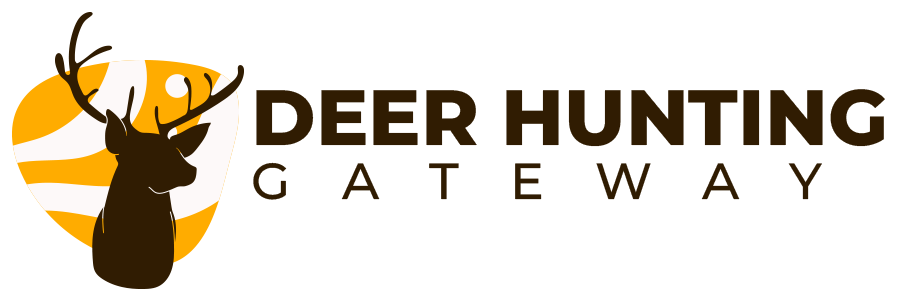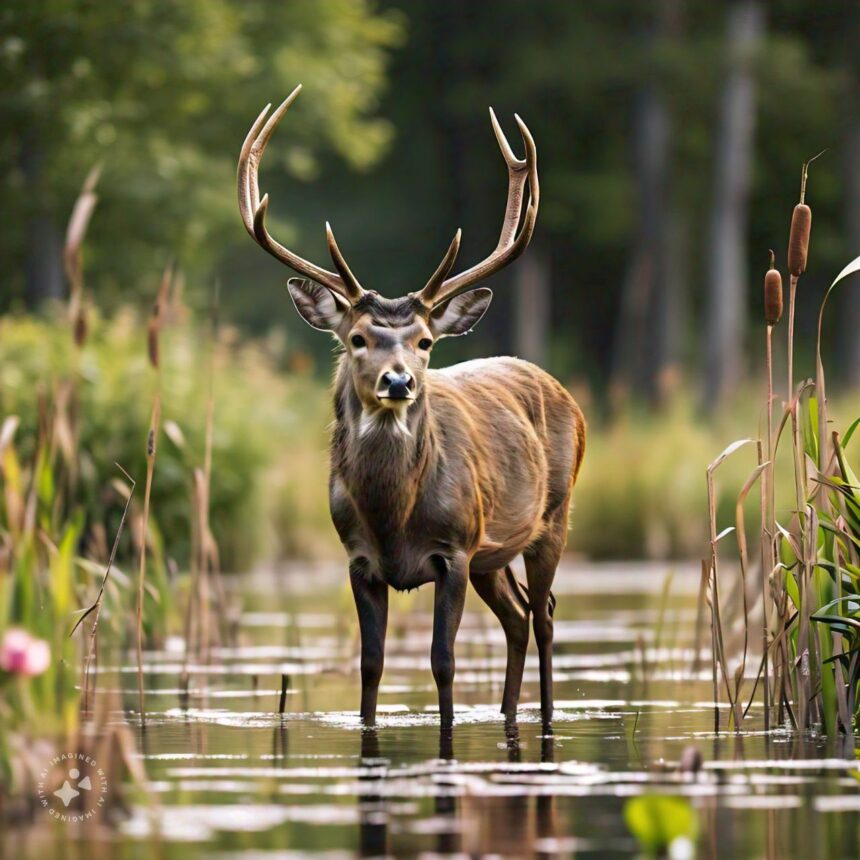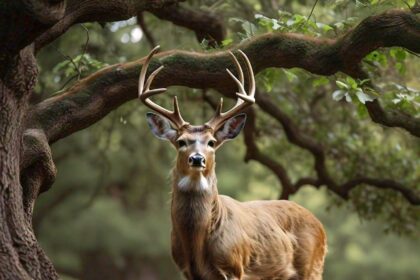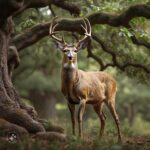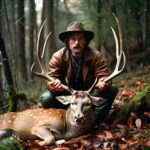Would you believe me if I told you that lots of people do not know the difference between deer species and an antelope? And would you be surprised if I also told you that there were no deer species found in Ghana originally? Most people either interchange them or consider all of them to be in the same family.
Deer
Antelope
Well let me enlighten you, Antelopes and deer are from different families. Antelopes belong to the Bovidae family, made up of sheep, goats and cattle; whereas deer are members of the Cervidae family, which includes muntjac, elk, red and fallow deer, reindeer, roe deer, and moose.
In this article, we are not going to talk about antelopes but we will be looking at some different species of deers, their taxonomy and classification and some endangered species.
Taxonomic Classification Of Deer
Family
Deer are in the family Cervidae, and in the family, there are two subfamilies.
Cervidae
The family Cervidae, commonly known as the deer family, encompasses a diverse group of hoofed ruminant mammals. Members of this family are characterized by their distinct features, including antlers (typically found only in males, with the exception of female reindeer) and a unique digestive system adapted for processing plant material. Deer are found in various habitats worldwide, from dense forests to open plains, showcasing their remarkable adaptability.
The Cervidae family is divided into two primary subfamilies Cervinae and Capreolinae, each comprising various species with unique traits and adaptations.
Subfamily Cervinae
- Cervinae, often referred to as the “Old World deer,” primarily inhabit Europe, Asia, and North Africa. This subfamily includes species such as:
Muntjac: Small deer known for their barking calls and short, simple antlers.
Elk (Red Deer): Large deer with impressive branching antlers, found in various regions including Europe and Asia.
Red Deer: Known for their large size and reddish-brown coats, these deer are native to Europe, Asia, and parts of North Africa.
Fallow Deer: Recognizable by their palmate antlers and spotted coats, fallow deer are native to Europe and Asia Minor.
Subfamily Capreolinae
- Capreolinae, or the “New World deer,” primarily inhabit the Americas but also have species in Eurasia. This subfamily includes:
(Caribou): Known for their migratory behavior and both males and females having antlers, reindeer are found in Arctic and Subarctic regions.
White-tailed Deer: Common in North America, these deer are identified by the white underside of their tails, which they raise as a warning signal.
Roe Deer: Small and agile, roe deer are native to Europe and Asia, recognized by their short antlers and reddish gray-brown coats.
Moose: The largest members of the deer family, moose are known for their broad, palmate antlers and are found in the Northern Hemisphere.
Classification Criteria
Deer classification is based on a combination of morphological, genetic, and ecological factors. Key criteria used in the taxonomic classification of deer include:
Antler Structure and Growth Patterns
The presence, shape, and branching patterns of antlers are critical in distinguishing between species and subfamilies. For example, members of Cervinae typically have larger, more complex antlers compared to the simpler antlers of some Capreolinae species.
Geographical Distribution
The natural habitats and geographic ranges of deer species play a significant role in their classification. Cervinae species are generally found in the Old World regions (Europe, Asia, and North Africa), while Capreolinae species are more common in the New World (the Americas) and parts of Eurasia.
Behavioral and Ecological Adaptations
Differences in feeding behavior, migratory patterns, and habitat preferences also contribute to the classification of deer. For instance, reindeer are known for their extensive migrations, while species like the white-tailed deer have more localized home ranges.
Genetic Studies
Advances in genetic research have provided deeper insights into the evolutionary relationships between different deer species. Molecular phylogenetics helps in tracing lineage divergences and understanding the genetic diversity within the Cervidae family.
Detailed Species Information
A. Habitat
Deer are highly adaptable animals that inhabit a wide range of environments across the globe. Their habitats vary significantly depending on the species and their geographical distribution:
Forests: Many deer species, such as the red deer and roe deer, are commonly found in deciduous and coniferous forests. These environments provide ample cover from predators and a rich source of food, including leaves, twigs, and fruits.
Savannas and Grasslands: Species like the white-tailed deer often inhabit open grasslands and savannas where they can graze on a variety of grasses and herbs. The open landscape allows them to spot predators from a distance.
Tundra: Reindeer, also known as caribou, thrive in the harsh conditions of the Arctic tundra. These deer are well-adapted to cold climates, and their migratory behavior helps them find food across vast areas.
Mountains: Species such as the moose and sambar deer are found in mountainous regions. They are adapted to rugged terrain and often inhabit areas near water sources like rivers and lakes.
Tropical Rainforests: Muntjac deer are known to inhabit dense tropical rainforests in Asia. These forests provide a diverse diet and protection from predators.
B. Behavior
Deer exhibit a range of behaviors that help them survive and thrive in their respective environments:
Feeding: Most deer are herbivorous, feeding on a diet of leaves, grasses, fruits, and bark. Their feeding patterns can vary from grazing in open fields to browsing in forests.
Social Structure: Social behavior in deer varies by species. Some, like the white-tailed deer, are often solitary or live in small family groups, while others, like the reindeer, form large herds, especially during migration.
Migration: Reindeer are known for their long migratory journeys, traveling hundreds of miles between their summer and winter ranges. This migration is driven by the search for food and favorable breeding conditions.
Reproduction: The mating season, or rut, typically occurs in the fall. During this time, males engage in combat to win the right to mate with females. Gestation periods vary by species, with most deer giving birth in the spring.
Communication: Deer use a variety of vocalizations, body language, and scent markings to communicate. For example, fawns bleat to call their mothers, and bucks use grunts and roars during the rut to establish dominance.
C. Biology
The biological traits of deer are adapted to their lifestyles and environments:
Digestive System: Deer are ruminants, meaning they have a complex stomach with multiple chambers to help break down tough plant material. This adaptation allows them to extract maximum nutrients from their diet.
Antlers: One of the most distinctive features of deer, antlers are grown and shed annually by males (except for female reindeer). Antlers are used for combat during the rut and can also serve as a display to attract females.
Senses: Deer have keen senses that help them detect predators. They have excellent hearing and a wide field of vision. Their sense of smell is also highly developed, allowing them to detect danger from a distance.
Physical Adaptations: Deer have strong, agile bodies built for running and jumping. This agility helps them escape predators. Their hooves are adapted to various terrains, providing stability and traction.
D. Appearance
Deer exhibit a wide range of physical appearances that are adapted to their environments:
Size: Deer sizes vary significantly among species. The small muntjac may weigh as little as 15 kg (33 lbs), while the large moose can weigh up to 700 kg (1540 lbs).
Coloration: Coat color varies by species and season. Many deer have reddish-brown coats in summer that change to grayish or darker tones in winter. This seasonal change helps them blend into their environments.
Antlers: The shape and size of antlers differ among species. Elk have large, sweeping antlers, while roe deer have smaller, simpler ones. The size and complexity of antlers often indicate the health and age of the deer.
Markings: Some deer species have distinctive markings. For example, the white-tailed deer has a characteristic white underside to its tail, which it raises when alarmed. Fallow deer are known for their spotted coats.
Endangered Deer Species
Over the years, the activities of Humans such as migration, infrastructure development, overhunting for food and other things has led to the demise of some species of deers. Today we have some species of deers that are endangered and if care is not taken, they will go extinct in 5 years.
A. Overview Of Endangered Species
Several deer species around the world face significant threats that have led to their endangered status. These threats include habitat loss, poaching, climate change, and human-wildlife conflict. Some of the most notable endangered deer species include:
Père David’s Deer (Elaphurus davidianus): Once native to the subtropical marshlands of China, this species was nearly driven to extinction in the wild due to habitat destruction and overhunting. Today, it survives primarily in captivity and through reintroduction efforts.
Philippine Spotted Deer (Rusa alfredi): Found only in the Philippines, this deer is critically endangered due to habitat loss from deforestation and hunting. Its population continues to decline despite conservation efforts.
Bactrian Deer (Cervus elaphus bactrianus): Native to Central Asia, the Bactrian deer faces threats from habitat fragmentation and poaching. It is classified as vulnerable, with decreasing population numbers.
Bawean Deer (Axis kuhlii): Endemic to Bawean Island in Indonesia, this small deer species is critically endangered due to its limited range and ongoing habitat degradation.
Kashmir Stag (Cervus elaphus hanglu): Also known as the Hangul, this species is found in the dense riverine forests of Kashmir in India. It is critically endangered due to habitat loss, poaching, and competition with livestock.
With this I fear that the next generations to come will not get to know about some of these Graceful Wanderers walking the face of the earth, let us all make it our duty to protect these wonderful creatures. We will be looking at conservation in my next article so stay tuned.
The Bottom Line
In conclusion, deer are a diverse and captivating group of animals that play vital roles in their ecosystems and hold significant cultural value. By deepening our understanding of their classification, behavior, and habitats, we can better appreciate the complexity and beauty of these graceful wanderers.
